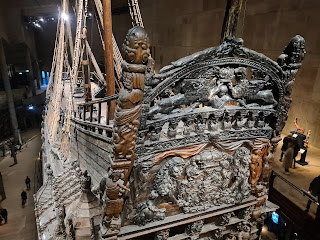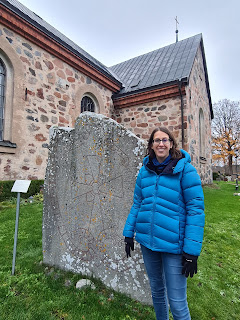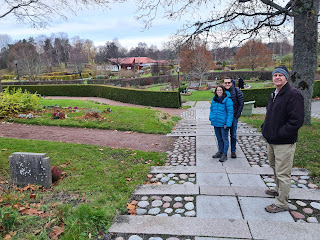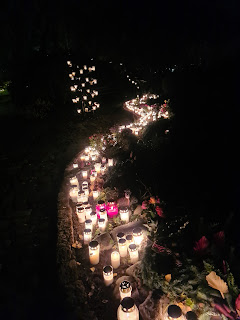Today is 2022 February 3 (my grandson Leon's 7th birthday) and I am just now catching up on pictures from our last six weeks in the amazing Sweden Stockholm Mission. A few more posts yet to do after this one . . .
Our daughter Michelle and her husband Andy took an 8-day holiday to Sweden, leaving their five children (ages 5-13) with Andy's mother (bless her heart!) So fun to show them sites around Stockholm and then fly south to Malmö where Andy's ancestors are from. Below are pictures from the first two days of their visit . . .
 |
| 2021 November 4. Elder & Syster McCauley arrived on the same day Andy & Michelle did. Fun to welcome a new senior couple. They will work in the city archives doing volunteer camera capturing of archival records. The McCauleys have served several missions, one being in Russia. L-R: President Davis, Elder & Syster McCauley, Syster Davis. |
 |
| We tried (and succeeded!) to keep Michelle & Andy awake till bedtime. Overseas travel is so exhausting, and the time difference doesn't help. Here they are in our tiny apartment. |
 |
| We took them to the Vasa Museum to see the amazing remains of the only almost fully intact 17th-century ship that has ever been salvaged. It's in amazing condition for having been in the depths of the sea for 333 years. |
 |
| The Vasa sank on its maiden voyage in Stockholm Harbor in 1623, having sailed only 1300 meters (1400 yards) before a breeze knocked the top-heavy ship onto its side. |
 |
| Michelle, LeRon, and Andy (and me too) got to view the ship from six different levels and from all sides. It's a very well-done museum. |
 |
| Many people, including the builders, knew the ship was too top-heavy to sail but they were under instructions from King Gustavus Adolphus to build it like he wanted and they didn't dare contradict him. The term vasa syndrome is now used in business circles to refer to problems with communication between workers and management. President Davis says we need to remember the vasa syndrome and work together as a mission. If we see things that need to be changed, we need to say something. |
 |
| King Gustavus didn't seem to care that many lives would be lost when his amazing ship sank. Next to Michelle and Andy and me, he was a very large man. Or maybe this is a heroic statue. I don't think the King was so heroic because his decisions led to the death of many people. |
 |
| Residues of paint on the 500 sculptures on the Vasa were still there after 333 years, and this replica shows how colorful it was. I bet it was quite the sight as it sailed into the sea, then listed to one side and slipped under the water. The guns were out for a gun salute and the water poured into the hold. The crew, along with their wives and children, were onboard for the maiden voyage; most survived but at least 30 lost their lives. Sad. |
 |
| We took Andy and Michelle to see the medieval Taby Kyrka which is known for the frescoes of Albertus Pictor that are painted on walls and ceiling. The paintings date to the 1400's and unlike many frescoes, were not whitewashed after the Reformation. The Taby Kyrka has the best preserved frescoes in Sweden. |
 |
| The church was built in the 1200's. This huge and very thick wooden door is original and is still used today, especially for brides and grooms to exit the church. |
 |
| Our friend Veronika works at the church and she unlocks this big door every day with this very large and heavy key. Click to enlarge so you can see the key. |
 |
| Colleen and Michelle are standing outside the very heavy wooden door. This is where brides and grooms exit the church after their weddings. Michelle is pointing to the place where the huge key is inserted to unlock the door. |
 |
Now we're on a hunt for original rune stones around Lake Vallentuna. This map shows where they are located. We started with #2 Taby Kyrka and worked our way counterclockwise, stopping at each rune stone and reading the description. The area was once owned by three farmers.
 | | Each rune stone has a rune (or message) on it. Signs gave us the translation. Rune stones were erected like we erect tombstones. They are usually in honor of someone who died and were placed there by a loved one. |
 | | This stone and others were placed along a causeway that was built through otherwise impassable wetland. The causeway and rune stones were built by a well-to-do landowner named Jarlabankes in 1050 A.D. |
 | | These stones and rune stones mark the path of the ancient causeway. |
|
 |
| Michelle and Andy are inspecting the rune stone at #9 -- Arkils tingstad. The stone tells of a local chief, Ulv, who lived here in the 11th century. Also, at this place, people came together to administer justice or to make important decisions for the community. |
 |
| We're at #8 Vallentuna Kyrka. The original church was built in the 1190's and was added on to and changed during the next several hundreds of years. |
 |
| The wooden pews are painted to look like marble. |
 |
| This more modern pipe organ was built in 1959. |
 |
| There are 7 rune stones in and around the church. One of the stones says, "Jarlabanke had this stone erected after him while he was alive, and he made this court, and alone he owned all this hundred." |
 |
The churches all have cemeteries in their yards and they are lovely and well-kept. I would like to be buried in a churchyard if I could . . . or on our farmland . . . or in the Grassy Lake Prairieview Cemetery . . .
|
 |
| Beautiful fall foliage and it's November and the grass is still green. |
 |
There is a lovely, peaceful feeling in this church yard. LeRon and I love to visit the old churches.
|
 |
| Love these old windmills that farmers used to mill their grain. |
 |
| The rune stone inscriptions are painted every once in a while so that they are still readable. |
 |
| Farmers work around the rune stones. Nice that they are still visible and that people care enough to take care of them so that all may enjoy. |
 |
This is stone #4 Fallbro. LeRon and I first discovered this stone as we were driving in the area looking for cropland. We had become tired of the city and took a Saturday drive out into the countryside searching for a bit of home (i.e. farmland). So this was our first rune stone find. I was excited to show Michelle. There was no English translation of this stone but the farmer Jarlabankes erected it. I wonder how hard it is to carve this stone. And I wonder how long it took.
 | | Last stop for the day . . . the Danderyd Kyrka with its beautiful cemetery all aglow for All Saints Eve. Tomorrow night we will see the big Skogskyrkogården, the biggest cemetery in Stockholm, and maybe in all of Sweden. Thousands of flickering candles will light the night sky. |
 | | On All Saints Eve, Swedes light a candle for deceased loved ones. If the graves are far away, then they put a candle in designated places like this. And some of these candles are for those who have no graves, such as those who have been cremated. Lighting the candles for loved ones is a wonderful tradition that LeRon and I would like to carry on at home in southern Alberta. |
|
 |
The bell tower by the Danderyd Kyrka is lovely in the night lights.
 | | So nice to be with our lovely daughter Michelle here in Stockholm! We thought none of our kids would visit us so we were very happy to welcome Michelle and Andy. |
|



































What a wonderful experience for the four of you to enjoy together!
ReplyDelete